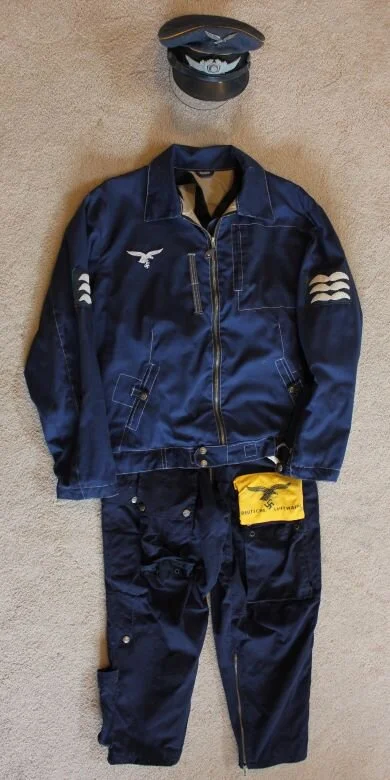More Luftwaffe Pilots:
Luftwaffe “Leutnant” Officer in Blue Shirt:
A Summer-Time look, with shoulder boards on the shirt, and decorations hung on it, generally would not be on there, as it is worn under a jacket, or a flight jacket, and might get a bit uncomfortable. He does have his Pilot’s Badge and the Knight’s Cross-Second Class Ribbon applied to the shirt now.
Major, Canal Jacket’ early 1940’s:
Feldwebel, Home-Defence Pilot, Canal Jacket :
Brown Leather Flight Jacket of the Luftwaffe:
*Brown Flight Jacket (#2):
*This Flight Jacket, I owned, but ended up giving back to the prior owner., all good, it was a great example.
Unterfeldwebel, Pilot, Black Flight Jacket:
Ok, no story here, lost what I had, and the few surviving pictures limit that. So you can just use your imagination, and you would be close, as the black, and brown, and fabric jackets were seen all over-especially by the end of the war. In the beginning, I think there was still a mix, much of the time.
Major, Group Leader:
For the longest time-I called this my “Galland" Jacket. The jacket has a custom-made, extra-large collar applied to it, to keep him a bit warmer at 40,000 feet in the winter, and the decorations sewn in place. But I haven’t found a picture of him in a jacket with such an exaggerated collar like this, but I like it! Galland has been photographed in a heavy winter jacket and another one, similar in looks to the “RAF” Bomber jacket.
This Pilot earned the medals of the German Cross in Gold, the Pilots Badge, Iron Cross 1st Class, and the “long-range” fighter clasp. In this photo shoot, we had him with the Knight’s Cross ar his throat as well. while standing at a pretty much abandoned air tower, will os “Stink-Bugs”.
Oberleutnant ‘Kommando Sperling’, 1./Versuchsverband, Arado Pilot:
On 2 August 1944, the first Arado (Ar) 234 reconnaissance sortie covered Cherbourg and the beachhead area flying from Juvincourt, in NE France, followed in the second half of August with flights over the southern part of England flown by Oberleutnant Erich Sommer. High altitude Ar 234 flights over the Thames Estuary and London by Kommando Sperling based at Rheine became relatively routine thereafter and the photographs they brought back were considered of the highest value by Hitler, Göring, OKW, and OKL.
The Arado 234 reconnaissance formations on the Western and Italian Fronts began with the detachment of the 1./Versuchsverband with two Ar 234 prototypes flown by Hptm. Horst Götz and Oblt. Erich Sommer. The pair operated from French and Dutch airfields during the summer of 1944 and in the autumn formed the nucleus of Kommando Sperling, equipped with the Ar 234 B and operating from Rheine. On 10 November, Sommer was detached south to Biblis to form the one-aircraft Kdo.Hecht. These would pave the way for two regular Staffeln, 1.(F)/123 and 1.(F)/100. After the latter became operational, Erich Sommer was sent to lead a three-aircraft Kommando in Italy.
The 1.(F)/123 had been operating with the Ju 88 T until it was withdrawn in July 1944 and disbanded in August. The 1.(F)/100 had been flying Ju 88s and 188s in the East; in September 1944, it relinquished all its aircraft, but it was not until December, in Jüterbog-Waldlager, that it received its first three Ar 234s.
These units flew as fuel permitted until the end of the conflict. The allies were very interested in the aircraft design and the pilots.
The pilot’s standard issue Fliegerbluse has officer insignia attached to include the rare BEVO officer national insignia. Of particular interest is his service in the east before his transfer into Kommando Sperling. He has been on the Ost Front since the first Winter, as we can see from his ribbon bar, and has spent the last parts of it working with the Romanian forces, hence his two Romanian awards. Both a pilot and trained observer, he wears the Flugzeugführer u. Beobachter-Abzeichen
A leather flight jacket, most likely worn with matching trousers and boots. Rank and national insignia can easily be removed, as can the Deutsche Luftwaffe armband, kept in a pocket with a safety pin, to be used to ensure the flyer is not mistaken for an Allied airman by the German population if forced to bail out.










































































































